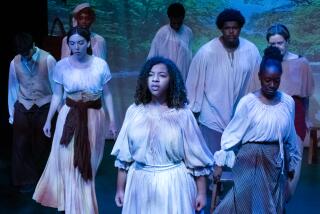RIOT AFTERMATH : COMMENTARY: BLACK, WHITE, ASIAN PERSPECTIVES ON THE RIOTS
- Share via
The day after the King verdict, I took my students to the Huntington Library and gardens for a long-planned field trip. I teach English and European history to 56 students, although on that day 36 showed up. About 45% of my students are Latino, 35% African-American, 12% Armenian and 8% Anglo.
All of my students are sweet. The stating of this in articles about teaching has been, to my mind, the single most glaring omission. The students are clever, bright, amusing, funny, and sweet, sweet, sweet. Every day they come to class, dressed in their ridiculous clothes, carefully chosen, ready to see what will happen today. Beneath all the toughness is still that child-trust that the teacher has planned a lesson for them. They do their part by getting there on time, ready; now the teacher will do her/his part.
On this Thursday, I found my African-American students looking to see what today’s lesson would be. How the verdict and the night’s horrors would be addressed would establish if aces were high or low--which was higher, the classroom’s sense of justice or Simi Valley’s?
If the classroom were fair, then the verdict would be an accident, would have to be overturned, the rioting and torching and looting frightening and excessive, even if emotionally understandable and satisfying. If the classroom ignored the verdict or supported it, then “There is no health in man/O Lord/Have mercy upon us.” The rioting and fires would be right and just and the appropriate channel for their youthful energies, idealism and anger.
By coming on the trip and not ditching school they voted with their feet. They voted to continue in their trust in the classroom, in school, in the Atticus Finch American way. (Every 10th-grader in California reads “To Kill a Mockingbird.”)
Silently, I had raked over the plan of spending two hours at the Huntington. Was this the best way to spend this unusual day? I decided to speak directly to the issue. I told them that in my view humans are the most extraordinary species on Earth. We are the cruelest species, the only one which commits genocide. But that we also are the most enlightened, the only one which has the capacity to feel a sense of justice and injustice. Bash a turtle and turtles will not rise up in rebellion. We are different from all other species on Earth--both for the good and the bad.
This King verdict, legally, is not over yet; but it may still not end justly. The point is there has always been injustice and justice with humans, and there always would be, that there always had been wild savagery with us and there always would be. We need to learn how to get along with each other, with ourselves, with our species as we’re not likely to change.
The exhibition at the Huntington is on the Spaniards first encountering the Aztecs, Mayans and Incas in the early 1500s. This was 500 years ago; the Spaniards reacted by murdering and
enslaving. Not all the Spaniards reacted this way; some looked at the NativeAmericans with interest, curiosity andrespect. They were in the vast minority, but their books, and drawings, and letters are right now on display at the Huntington.
My students spent the day in the 1500s New World. They spent it seeing themselves reflected in mirror upon mirror. They saw themselves in their anger at the King verdict, in their readiness to feel like killing, as Spanish conquistadors, as enraged Native Americans, as brutal Europeans killing their own sort.
My black students, my Hispanic students, Armenian students, Anglo students, myself, we all often need our fictions--and we are the unhappy recipients of other people’s fictions of us. Not only do we all need to learn to live together, we need to learn to see each other accurately, to see what we look like, what we are like, what we value. We need to see the otherness for exactly what it is. Then we may begin to learn how to get along.
More to Read
Sign up for Essential California
The most important California stories and recommendations in your inbox every morning.
You may occasionally receive promotional content from the Los Angeles Times.













